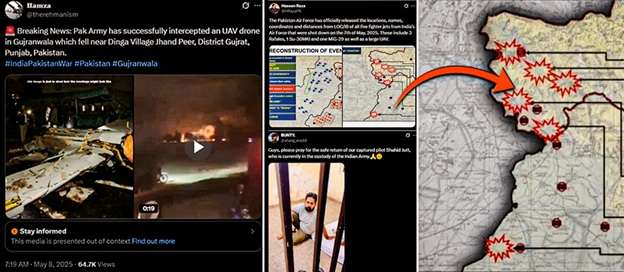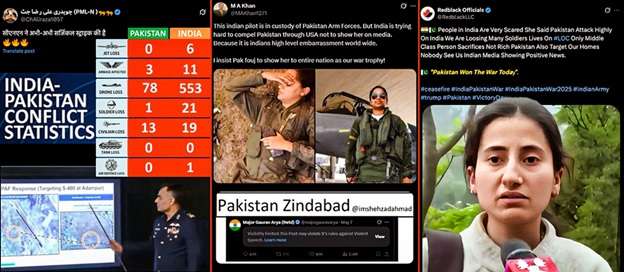In the contemporary landscape of hybrid warfare, information has become as potent a weapon as conventional firepower. Pakistan’s ongoing confrontation with India has increasingly moved into the psychological and digital realms, where narrative manipulation and perception warfare play a central role. Following the Indian Armed Forces’ surgical operation Operation Sindoor in response to a terror attack in Pahalgam that claimed 26 civilian lives, Pakistan has escalated its use of misinformation as a core strategic instrument.
Background: Operation Sindoor and the Trigger Point
Targeting nine terrorist hideouts around the Line of Control and Pakistan, India began Operation Sindoor, a concerted precision and strategic operation, on May 7, 2025. This was a direct reaction to the terror incident in Pahalgam, which featured the signatures of organizations supported by Pakistan and based in the Indian border regions. India reiterated that it is a military attack that is precisely targeted at terror camps and does not damage Pakistan’s military or civilian infrastructure.
Pakistan, while denying the presence of any terror infrastructure at the targeted site, did not deny that an airstrike had occurred. Instead, it claimed that India had attacked a military installation and vowed to respond. This statement set the stage for a highly orchestrated misinformation campaign aimed at distorting facts, deflecting blame, and garnering international sympathy.
- Discrediting Indian military claims
- Evading internal backlash for intelligence and security failures
- Mobilising domestic support through the illusion of victory
- Reaping international sympathy and potential financial aid
Internal Pressures Fueling Narrative Manipulation
Pakistan’s aggressive use of disinformation is closely tied to its internal crises, including:
a. Economic Collapse
With dwindling foreign reserves, a depreciating currency, and an inability to sustain military maintenance, Pakistan’s economic condition is dire. Defence budgets have been slashed, and many of the country’s aircraft and ground assets remain non-operational due to lack of funding.
b. Balochistan and Separatist Movements
The Balochistan separatist conflict has intensified, marked by frequent attacks on infrastructure and the military. This persistent unrest weakens national unity and questions the state’s grip on its own territory.
At the same time, Khyber Pakhtunkhwa continues to be a hotbed of Terrorism, with a rise in terrorist attacks that target both civilians and security forces. The region has become even more unstable due to the porous border with Afghanistan and the reappearance of Tehrik-i-Taliban Pakistan (TTP), which has made Pakistan’s internal security issues worse and undermined the power of the federal government.
c. Political Fragility
The civilian government in Islamabad is under constant pressure from both the military establishment and opposition coalitions. A full-blown political crisis is seen as a likely outcome if public trust in the government and armed forces deteriorates further.
Victory parades in the metaverse appear to be a new approach for Pakistan to raise spirits amid growing internal unrest. Videos of Pakistanis celebrating a purported military victory over India, complete with pyrotechnics, flag-waving, and victory pronouncements, recently went viral on social media. The story claims that in addition to being defeated, India was left begging for a truce. There had been no real combat, of course. Such disinformation acts as a national stress reliever in a reality where the ground situation is far less flattering; it’s like a digital aspirin for geopolitical migraines.
Anatomy of Pakistan’s Misinformation Campaign
Post-Operation Sindoor, Pakistan’s state-aligned influencers and media networks launched a high-frequency, coordinated digital disinformation campaign. Monitoring patterns show updates occurring every 10–15 minutes across platforms like Twitter (X), Telegram, YouTube, and Instagram.
Key Claims Pushed:
- Multiple Rafale jets shot down by Pakistan Air Force
- Capture of an Indian female fighter pilot
- Ceasefire was a result of Indian pleading via the United States
- Indian airstrikes were ineffective, with no damage on Pakistani soil
- Widespread Kashmiri support for Pakistan through commodity exchanges
- India resorted to banning social media accounts, and Pakistan is “retaliating in kind”
These claims often use gamified language such as:
- “One Rafale down”
- “Second neutralized”
- “Hattrick by Pakistan Army”
- “Sixer across LoC”
Strategic Objectives of the Narrative Warfare
a. Projecting Strength Amidst Weakness
Pakistan’s conventional military limitations are being masked by an exaggerated digital show of force. The disinformation serves to simulate military parity with India, despite reality indicating otherwise.
b. Engineering Victimhood for Financial Leverage
By positioning itself as a target of Indian aggression, Pakistan seeks to draw support from global financial bodies like the International Monetary Fund and World Bank. The goal is to unlock emergency loans, humanitarian relief, and diplomatic leniency.
c. Morale Management
With confidence in the Pakistani establishment waning due to inflation, corruption, and separatist activity, a strong military narrative is vital for domestic cohesion. Fake victories and media manipulation help control public perception and suppress dissent..
The Role of Digital Platforms in Propaganda Amplification
Pakistan’s digital strategy mirrors the playbook of other states engaged in hybrid conflict (such as Russia, Iran, and China). Official military media, ex-ISPR (Inter-Services Public Relations) spokesmen, and pro-army influencers distribute doctored images, AI-generated war footage, recycled video content, and fake maps to create confusion and manipulate global discourse.
India’s digital counterintelligence teams have flagged and DE platformed dozens of such accounts, but Pakistan has responded by removing Indian content and profiles in retaliation, further fueling the digital arms race.
Conclusion
Pakistan uses disinformation warfare as a fundamental strategy for national survival, not as a stand-alone effort. When faced with internal instability, economic decline, and operational weakness, the state uses narrative dominance as a coping mechanism. Digital triumphs frequently take the place of actual ones in this environment. In order to reassure the people back home that their leadership is still strong and in control, Pakistani information circuits, for example, have spread the notion that General Asim Munir has not only taken command but has been promoted to Field Marshal in response to India’s claim that he has gone into hiding due to pressure. India must treat psychological operations as an offensive strategic advantage as well as a defensive requirement as traditional combat becomes more and more entwined with digital influence.



